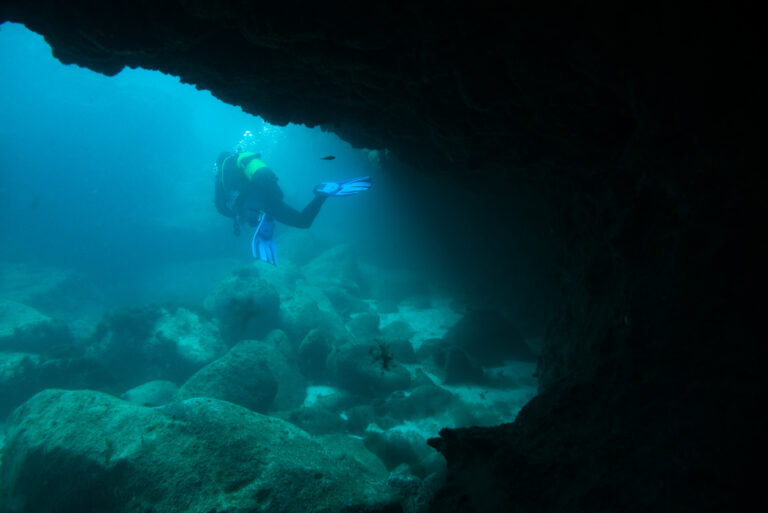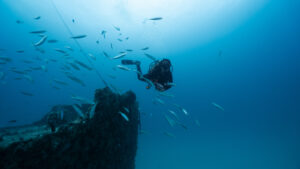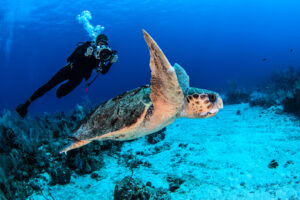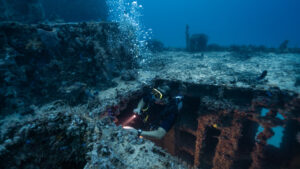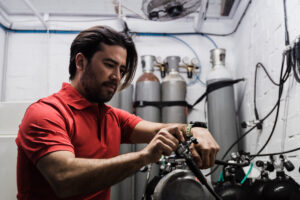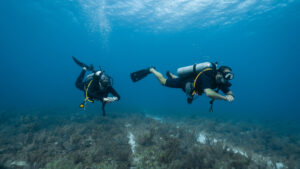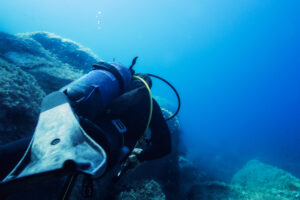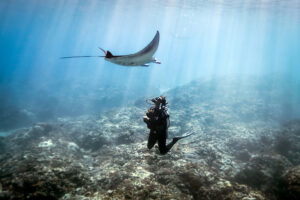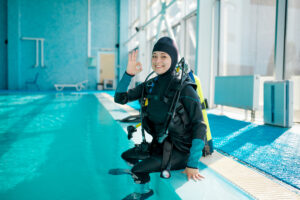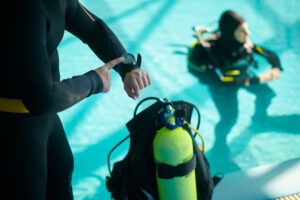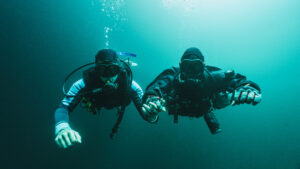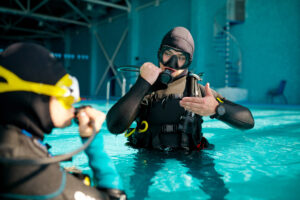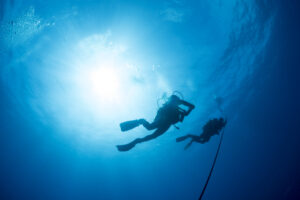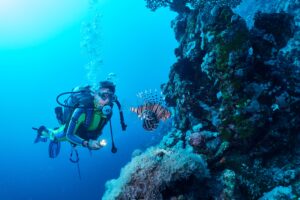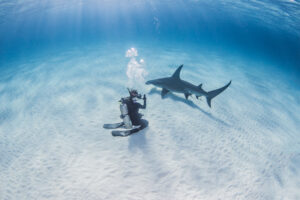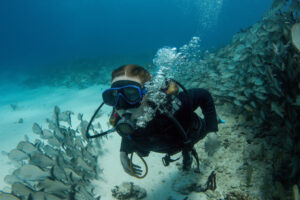What is an Over Pressure Valve?
An over pressure valve (OPV) is a critical component in scuba diving equipment designed to prevent the dangerous buildup of pressure within sealed systems. These valves automatically release excess pressure, ensuring the safety and functionality of diving apparatus such as buoyancy control devices (BCDs), drysuits, and rebreathers. The primary function of an OPV is to maintain safe pressure levels, thereby protecting divers from equipment failures that could lead to hazardous situations underwater.
Historical Development
The concept of pressure regulation is not new and can be traced back to early steam engines and industrial applications where maintaining optimal pressure was crucial to prevent catastrophic failures. The introduction of OPVs into scuba diving equipment marked a significant advancement in underwater safety. In the early days of diving, the primary focus was on improving the durability and reliability of diving suits and air supply systems. As diving technology evolved, the need for precise pressure control became evident.
The first OPVs specifically designed for diving were developed in the mid-20th century, coinciding with the increasing popularity of recreational scuba diving. These early valves were simple mechanical devices that provided a rudimentary level of protection. However, as diving practices became more sophisticated and divers began exploring greater depths, the limitations of these early valves became apparent. This led to the development of more advanced and reliable OPVs, incorporating materials and engineering techniques from the aerospace and automotive industries.
By the late 20th century, OPVs had become a standard feature in most scuba diving equipment. The integration of these valves into BCDs and drysuits was a game-changer, allowing divers to control buoyancy and manage pressure with greater precision and safety. The evolution of OPVs reflects the broader trends in diving technology, characterized by a continuous push towards enhancing safety, reliability, and user experience.
Design and Functionality
The design of an OPV is a marvel of engineering, combining simplicity with reliability. At its core, an OPV consists of a spring-loaded valve mechanism that opens to release excess pressure when it exceeds a predetermined threshold. This threshold is carefully calibrated to ensure that the valve operates effectively under the specific conditions of scuba diving. The materials used in OPV construction are chosen for their durability and resistance to corrosion, given the harsh underwater environment.
In buoyancy control devices, OPVs play a vital role in preventing over-inflation. When a diver inflates their BCD, the air bladder expands to provide lift. If too much air is introduced, the OPV opens to vent the excess, thus preventing the bladder from bursting. This automatic release of pressure is crucial during ascents, where decreasing ambient pressure can cause the air in the BCD to expand rapidly.
In drysuits, OPVs help manage the internal pressure to ensure comfort and mobility. As a diver descends, the water pressure increases, compressing the suit and reducing insulation. By adjusting the air volume inside the suit, divers can maintain a balance between warmth and buoyancy. The OPV ensures that any excess air is safely vented, preventing the suit from becoming too buoyant and causing an uncontrolled ascent.
Rebreathers, which recycle exhaled air to extend dive times, also rely on OPVs to maintain safe pressure levels within the breathing loop. These systems are more complex, involving multiple valves and sensors to ensure optimal performance. The OPV in a rebreather must be precisely tuned to handle the unique pressure dynamics of the closed-loop system, ensuring that the diver receives a consistent and safe supply of breathable gas.
Types of Over Pressure Valves
There are several types of OPVs used in scuba diving, each designed to meet specific needs and conditions. The most common types include spring-loaded, diaphragm, and pilot-operated valves. Spring-loaded valves are the simplest and most widely used. They consist of a spring and a valve seat, with the spring tension determining the pressure at which the valve opens. These valves are reliable and easy to maintain, making them ideal for recreational diving equipment.
Diaphragm valves offer more precise pressure control and are often used in technical diving gear. These valves use a flexible diaphragm to respond to changes in pressure, providing smoother and more accurate operation. The diaphragm separates the control chamber from the process fluid, ensuring that the valve operates reliably even in harsh conditions.
Pilot-operated valves are used in advanced diving systems, such as rebreathers and high-performance BCDs. These valves use a small pilot valve to control the opening and closing of the main valve, allowing for very fine adjustments in pressure. Pilot-operated valves are highly responsive and can handle large variations in pressure, making them suitable for deep diving and other demanding applications.
Each type of OPV has its advantages and limitations, and the choice of valve depends on the specific requirements of the diving equipment and the conditions in which it will be used. Understanding the different types of OPVs and their applications is crucial for divers and equipment manufacturers alike, as it ensures that the right valve is used for the right purpose.
Safety and Risks
The primary role of an OPV is to enhance diver safety by preventing the buildup of dangerous pressures within the diving equipment. However, like any mechanical device, OPVs can malfunction, and understanding the potential risks is essential. One common issue is valve sticking, where the valve fails to open or close properly due to debris, corrosion, or mechanical wear. Regular maintenance and inspection can help prevent such issues, ensuring that the valve operates smoothly.
Another risk associated with OPVs is incorrect calibration. If the pressure threshold is set too high or too low, the valve may not function as intended. For example, a valve set too high may fail to release excess pressure, leading to equipment damage or failure. Conversely, a valve set too low may vent prematurely, affecting buoyancy and control. Proper calibration is crucial, and divers should follow manufacturer guidelines and have their equipment checked by qualified technicians.
Despite these risks, OPVs are highly reliable when maintained properly. They provide an essential layer of protection, preventing over-pressurization and the associated dangers. Divers should be aware of the signs of valve failure, such as unusual sounds or difficulty in controlling buoyancy, and address any issues promptly. By following best practices for maintenance and operation, divers can ensure that their OPVs function correctly and contribute to a safe and enjoyable diving experience.
Maintenance and Troubleshooting
Maintaining an OPV is relatively straightforward but requires attention to detail. Regular inspections are crucial to identify any signs of wear or damage. Divers should check for debris or corrosion around the valve opening and ensure that the spring and diaphragm (if present) are in good condition. Cleaning the valve with fresh water after each dive can help prevent salt and mineral buildup, which can interfere with the valve’s operation.
In addition to visual inspections, functional tests should be performed periodically. This involves checking the valve’s response to pressure changes, ensuring that it opens and closes smoothly. If any issues are detected, the valve should be serviced or replaced by a qualified technician. Keeping a record of maintenance and inspections can help track the valve’s performance and identify patterns that may indicate underlying problems.
Common issues with OPVs include leaks, sticking, and incorrect pressure settings. Leaks can occur due to worn seals or damaged components and should be addressed immediately to prevent equipment failure. Sticking can often be resolved by cleaning the valve and ensuring that all moving parts are free of debris. If the pressure setting is incorrect, the valve should be recalibrated according to the manufacturer’s specifications.
By following these maintenance and troubleshooting guidelines, divers can ensure that their OPVs remain in good working condition. This not only enhances safety but also extends the lifespan of the equipment, providing reliable performance over many dives.
Regulatory and Standards Overview
The use of OPVs in scuba diving equipment is governed by various regulations and standards to ensure safety and reliability. These regulations are established by international and national organizations, including the International Organization for Standardization (ISO), the European Committee for Standardization (CEN), and the American Society for Testing and Materials (ASTM). These bodies set the standards for design, manufacturing, testing, and performance of OPVs.
One of the key standards for OPVs in diving equipment is ISO 10297, which specifies the requirements for valves used in compressed gas cylinders, including those used in diving. This standard covers aspects such as materials, design, performance, and testing, ensuring that the valves can withstand the pressures and conditions encountered during diving. Compliance with ISO 10297 is mandatory for manufacturers wishing to market their products internationally.
In addition to ISO standards, the European Norm (EN) standards also apply to diving equipment used in Europe. EN 250, for example, specifies the requirements for respiratory equipment used in scuba diving, including the performance and safety of OPVs. These standards are enforced by regulatory bodies such as the European Union (EU) and national authorities, ensuring that all diving equipment sold in Europe meets the highest safety standards.
In the United States, the ASTM provides guidelines for the testing and certification of diving equipment, including OPVs. ASTM standards ensure that the valves are tested under realistic conditions and provide reliable performance. Manufacturers must adhere to these standards to receive certification and sell their products in the US market.
Overall, these regulations and standards play a crucial role in ensuring the safety and reliability of OPVs in scuba diving equipment. By adhering to these guidelines, manufacturers can produce high-quality valves that meet the needs of divers worldwide.
Key Takeaways
Over pressure valves are essential components in scuba diving equipment, providing critical protection against over-pressurization and ensuring the safety of divers. Their design and functionality have evolved significantly over the years, incorporating advanced materials and engineering techniques. Understanding the different types of OPVs and their specific applications is crucial for choosing the right equipment. Regular maintenance and adherence to regulatory standards are key to ensuring reliable performance and enhancing diver safety. Properly functioning OPVs contribute to a safer and more enjoyable diving experience, underscoring their importance in modern diving practices.

